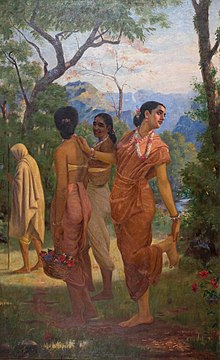Antariya

An antariya (antarīya) is a lower body garment from ancient India. It is a long white or coloured strip of cotton passed through the legs, tucked at the back and covering the legs loosely, then flowing into long pleats at front of the legs.[1][2][3][4]
History
The antariya is an ancient garment mentioned in the Ramayana and the Mahabharata.[5] Hindu deities can be seen wearing the uttariya and the antariya in sculptures in the Indian subcontinent,[6] especially in Hindu temples and other forms of iconography.
As mentioned in Buddhist Pali literature during the 6th century BC, Sari śāṭikā (Sanskrit: शाटिका) is an evolved form of the antariya, which was one of three-piece attire worn by women during the ancient period.[1][2][3][7][8][9]
Terminology
The word antariya is of Sanskrit origin.[10]
Use
The antariya was usually made of fine cotton or silk. It was usually used in combination with the uttariya.
Gallery
-
 Women in choli (blouse) and antariya c. 320 CE, Gupta Empire
Women in choli (blouse) and antariya c. 320 CE, Gupta Empire - Relief depicting men in antariya and uttariya, 1st century CE
See also
- Aprapadina
- Uttariya
- Sari
- Choli
- Nivi (garment)
References
- ^ a b Nair, Rukmini Bhaya; deSouza, Peter Ronald (2020-02-20). Keywords for India: A Conceptual Lexicon for the 21st Century. Bloomsbury Publishing. ISBN 978-1-350-03925-4.
- ^ a b Mehta, Tarla (1995). Sanskrit Play Production in Ancient India. Motilal Banarsidass Publ. ISBN 978-81-208-1057-0.
- ^ a b Ayyar, Sulochana (1987). Costumes and Ornaments as Depicted in the Sculptures of Gwalior Museum. Mittal Publications. p. 62. ISBN 978-81-7099-002-4.
- ^ Shastri, Ajay Mitra; Varāhamihira (1996). Ancient Indian Heritage, Varahamihira's India: Historical geography, religion, and society. Aryan Books International. p. 224. ISBN 978-81-7305-081-7.
- ^ McLain, Karline (2009). India's Immortal Comic Books: Gods, Kings, and Other Heroes. Indiana University Press. p. 72. ISBN 978-0-253-22052-3.
- ^ Ancient India. Director General of Archaeology in India. 1950. p. 37.
- ^ Prasad Mohapatra, Ramesh (1992). Fashion Styles of Ancient India: A Study of Kalinga from Earliest Times to Sixteenth Century Ad. B.R. Publishing Corporation. p. 35. ISBN 9788170187233.
- ^ Prachya Pratibha, 1978 "Prachya Pratibha, Volume 6", p. 121
- ^ Agam Kala Prakashan, 1991 "Costume, coiffure, and ornaments in the temple sculpture of northern Andhra", p. 118
- ^ www.wisdomlib.org (2018-05-06). "Antariya, Antarīya: 7 definitions". www.wisdomlib.org. Retrieved 2020-12-09.
- v
- t
- e
- Four Noble Truths
- Three Jewels
- Noble Eightfold Path
- Nirvana
- Middle Way
- Tathāgata
- Birthday
- Four sights
- Eight Great Events
- Great Renunciation
- Physical characteristics
- Life of Buddha in art
- Footprint
- Relics
- Iconography in Laos and Thailand
- Films
- Miracles
- Family
- Suddhodāna (father)
- Māyā (mother)
- Mahapajapati Gotamī (aunt, adoptive mother)
- Yaśodharā (wife)
- Rāhula (son)
- Ānanda (cousin)
- Devadatta (cousin)
- Places where the Buddha stayed
- Buddha in world religions
- Kaundinya
- Assaji
- Sāriputta
- Mahamoggallāna
- Ānanda
- Mahākassapa
- Aṅgulimāla
- Anuruddha
- Mahākaccana
- Nanda
- Subhūti
- Punna
- Upāli
- Mahapajapati Gotamī
- Khema
- Uppalavanna
- Asita
- Channa
- Yasa
- Avidyā (Ignorance)
- Bardo
- Bodhicitta
- Buddha-nature
- Dhamma theory
- Dharma
- Enlightenment
- Five hindrances
- Indriya
- Karma
- Kleshas
- Mental factors
- Mindstream
- Parinirvana
- Pratītyasamutpāda
- Rebirth
- Saṃsāra
- Saṅkhāra
- Skandha
- Śūnyatā
- Taṇhā (Craving)
- Tathātā
- Ten Fetters
- Three marks of existence
- Two truths doctrine
- Ten spiritual realms
- Six realms
- Deva realm
- Human realm
- Asura realm
- Hungry Ghost realm
- Animal realm
- Naraka
- Three planes of existence
- Bhavana
- Bodhipakkhiyādhammā
- Brahmavihara
- Buddhābhiṣeka
- Dāna
- Devotion
- Deity yoga
- Dhyāna
- Faith
- Five Strengths
- Iddhipada
- Meditation
- Merit
- Mindfulness
- Nekkhamma
- Nianfo
- Pāramitā
- Paritta
- Puja
- Offerings
- Prostration
- Chanting
- Refuge
- Sādhu
- Satya
- Seven Factors of Enlightenment
- Sati
- Dhamma vicaya
- Pīti
- Passaddhi
- Śīla
- Threefold Training
- Vīrya
- Twenty-two vows of Ambedkar
- Gautama Buddha
- Nagasena
- Aśvaghoṣa
- Nagarjuna
- Asanga
- Vasubandhu
- Kumārajīva
- Buddhaghosa
- Buddhapālita
- Dignāga
- Bodhidharma
- Zhiyi
- Emperor Wen of Sui
- Songtsen Gampo
- Xuanzang
- Shandao
- Padmasambhāva
- Saraha
- Atiśa
- Naropa
- Karmapa
- Hōnen
- Shinran
- Dōgen
- Nichiren
- Shamarpa
- Dalai Lama
- Panchen Lama
- Ajahn Mun
- B. R. Ambedkar
- Ajahn Chah
- Thích Nhất Hạnh
- Timeline
- Ashoka
- Kanishka
- Buddhist councils
- History of Buddhism in India
- Great Anti-Buddhist Persecution
- Greco-Buddhism
- Buddhism and the Roman world
- Buddhism in the West
- Silk Road transmission of Buddhism
- Persecution of Buddhists
- Banishment of Buddhist monks from Nepal
- Buddhist crisis
- Sinhalese Buddhist nationalism
- Buddhist modernism
- Vipassana movement
- 969 Movement
- Women in Buddhism
- Abhijñā
- Amitābha
- Brahmā
- Dharma talk
- Hinayana
- Kalpa
- Koliya
- Lineage
- Māra
- Ṛddhi
- Siddhi
- Sacred languages
 Category
Category Religion portal
Religion portal























